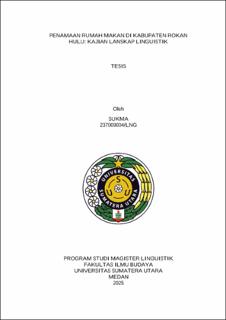Penamaan Rumah Makan di Kabupaten Rokan Hulu: Kajian Lanskap Linguistik
Naming of Restaurants in Rokan Hulu Regency : A Study of Linguistic Landscape
Abstract
This research aims to analyze the linguistic units, meanings, and cultural values in the naming of restaurants in Rokan Hulu Regency. This research uses a qualitative approach, with data collected through direct observation and interviews. The method of data analysis used in this research is the equivalent method, utilizing determinant sorting and referential sorting techniques. The analysis of linguistic units is conducted using Kridalaksana’s concept of linguistic units; meanings are examined through the Natural Semantic Metalanguage theory by Goddard and Wierzbicka and Van Leeuwen’s multimodal theory; while cultural values are identified based on Leon Dyczewski’s theory of cultural values. The results indicate that: (1) the linguistic units found on restaurant signboards in Rokan Hulu take the form of words (nouns, numerals, adverbs, and adjectives) and phrases (noun phrases, verb phrases, numeral phrases, and adjective phrases); and (2) the meanings reflected in the restaurant names include self-identifiers, ethnic names, regional names, greeting expressions, positive word associations, food menus, natural elements, family elements, friendship elements, and cooking utensils. Furthermore, visual elements such as images, logos, colors, typography, and signboard shapes reinforce the identity and visual communication strategies of restaurant owners; and (3) the cultural values identified include identity, harmony, family, religious, hope, solidarity, and nationalism values. The research concludes that the naming of restaurants in Rokan Hulu reflects the use of heterogeneous language and aligns with the cultural values of the local community.

